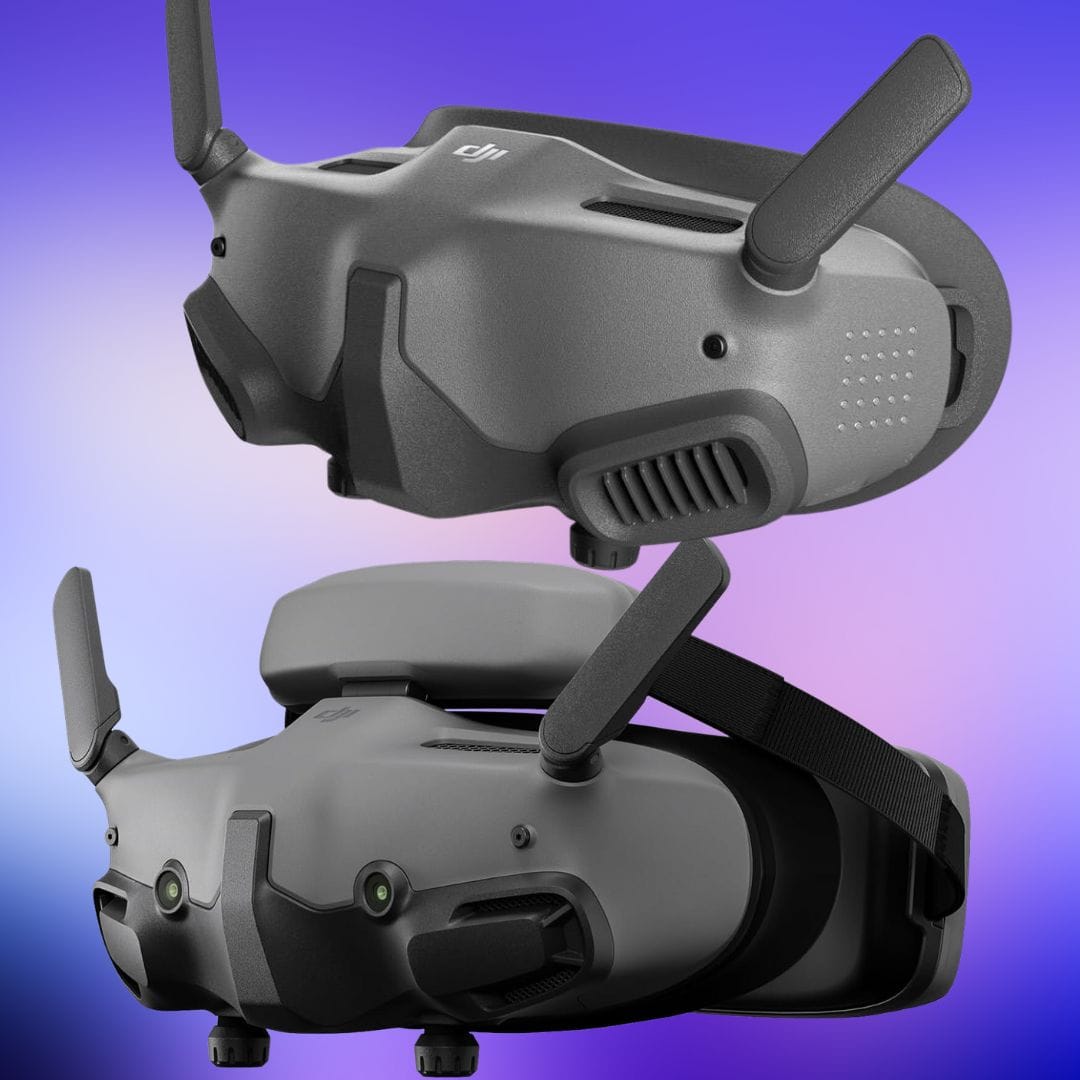Should You Upgrade?
Ah, the age-old tale of tech upgrade temptation! Enter the DJI Goggles 3, swooping in with promises of better, faster, and stronger experiences. But is it truly the hero we didn’t know we needed, or just a flashy new suit on an old superhero? Let’s dissect the DJI Goggles 3 and its predecessor, the Goggles 2, to determine if it's worth the leap.
Specifications Comparison
| Feature | DJI Goggles 3 | DJI Goggles 2 | DJI Goggles Integra |
|---|---|---|---|
| Display Size | 2 x 0.49″ OLED | 2 x 0.49″ OLED | 2 x 0.49″ OLED |
| Display Resolution | 1920×1080 | 1920×1080 | 1920×1080 |
| Refresh Rate | 100Hz | 100Hz | 100Hz |
| Feed Resolution | 1080p 60/100fps | 1080p 60/100fps | 1080p 60/100fps |
| Frequency Range | 2.400-2.4835GHz, 5.170-5.250GHz, 5.725-5.850GHz | 2.400-2.4835GHz, 5.725-5.850GHz | 2.400-2.4835GHz, 5.725-5.850GHz |
| Field of View (FOV) | 44° | 51° | 44° |
| Display Scaling | 50% to 100% | 50% to 100% | 50% to 100% |
| IPD Adjustment | 56 to 72mm | 56 to 72mm | 56 to 72mm |
| Power Input | Integrated battery (7.2V 3000mAh, 21.6Wh) | 9V Input, Dedicated Battery (2S 1800mAh, 18Wh) | Integrated battery (7.2V 2500mAh, 17.64Wh) |
| Weight | 470g | 290g | 410g |
| Price | US$499 | US$449 | US$349 |
Design & Comfort: Aesthetic Overhaul or Just a New Hat?
At first glance, the DJI Goggles 3 (G3) seems like it just got back from a spa retreat, flaunting a design that prioritizes comfort without morphing into an unrecognizable gadget. The head strap now connects to a forehead pad, quite a shift from the traditional side attachment, aiming to alleviate the common "goggle headache". It’s like they’ve swapped yoga for pilates — different approach, same goal: comfort.
Vision Quest: Seeing the World Through HD Lenses
Both the Goggles 2 and 3 offer a delightful 1920x1080 display resolution on their 0.49" OLED screens. The refresh rate is a smooth 100Hz, which is akin to ensuring your digital world is as buttery as that overpriced popcorn at the cinema.


However, the Goggles 3 narrows the field of view to 44° from the 51° of the Goggles 2. DJI claims this reduction sharpens your focus and keeps the dreaded blurry edges at bay. It’s a bit like choosing a smaller, more refined window to reality — less peripheral distraction, more main-event action.
Power Play: Battle of the Batteries
The G3 touts an integrated battery, likely inspired by the mantra, "Why hang onto something detachable when you can make it a seamless part of your attire?" This integrated approach translates to a heftier 470g weight compared to the G2’s lighter 290g. But, hey, no more fumbling for a separate battery pack, or requiring a DIY mod.

Tech Specs: More Than Just Numbers
DJI has equipped the G3 with OcuSync 4.0, the latest iteration of their transmission technology promising lower latency and higher bitrate — essential for those who live their life a quarter millisecond at a time. It’s like trading up from a reliable sedan to a sportier model; both get you there, but one does it with a bit more zing.
Real-time Live View: Gimmick or Game-Changer?
New to the scene is the G3’s Real-time Live View, using dual front-facing cameras to let you peek at the real world without removing the goggles. It’s kind of like having x-ray vision, only less superheroic and more practical, though some might find it underwhelming at just 720p. It also seems to be zoomed in slightly, making it awkward to use practically.

The Good
- Enhanced Comfort: The redesigned head strap and forehead pad integration aim to increase comfort for long-term wear, reducing the dreaded drone-goggle headache.
- Sharper Visuals: The narrower 44° field of view might sound limiting, but it actually helps focus the visuals, eliminating the blurry edges that plagued the wider 51° view of the Goggles 2.
- OcuSync 4.0: With lower latency and higher bitrate, the upgraded transmission system ensures smoother, more responsive control, and crisper visuals during flight.
- Integrated Battery Design: Say goodbye to external battery woes. The built-in battery not only streamlines the design but also offers a longer and more reliable power supply.
- Real-time Live View: This new feature, albeit at a lower resolution, allows pilots to quickly check their surroundings without removing the goggles — a handy tool for maintaining situational awareness.
The Bad
- Non-Removable Antennas: The shift to non-removable antennas may simplify the design but limits customization and upgrades with aftermarket options.
- Heavier Weight: The integration of the battery and additional features bump up the weight to 470g, which could be a downside for those sensitive to heft.
- Narrower FOV: While the narrower field of view enhances focus, it might not appeal to everyone, especially those who prefer a more immersive, panoramic experience.
- Compatibility Issues: Currently, the G3 is only compatible with the latest DJI drones. This limitation could be a significant drawback for users with older models or custom-built setups.
Rimzler has a great discussion on his opinion between the goggles 2 and goggles 3 from an FPV pilot perspective at the 24min mark on his recent YouTube video that is worth checking out if you are looking to buy the DJI Goggles 3:
Should You Buy the DJI Goggles 3?
The decision to invest in the DJI Goggles 3 hinges largely on what you value most in your FPV experience. Here’s why you might consider a purchase:
- Go for It If: You’re using or plan to use compatible DJI drones like the Avata 2, DJI Air 3, and Mini 4 Pro. The enhanced features and improved comfort of the G3 will elevate your flying experience, making it a worthy upgrade.
- Maybe Not Yet: You’re deeply embedded in the DIY drone scene or rely on older DJI models. The current compatibility restrictions and lack of significant leaps in core features like display resolution might not justify the upgrade cost from G2 to G3.
I am sure DJI will add backwards compatibility in the future (as they have for all of their previous DJI goggles), but there is no promise to do so. So if you are into building, or flying other FPV drones with the DJI O3, its best to wait this out before choosing to upgrade. Personally if you already have the Goggles 2, there is little reason to upgrade to Goggles 3 at the moment. However, if you are on the older first generations goggles, or Goggles Integra, I would keep an eye on the release notes and buy a set of Goggles 3 as soon as they have backwards compatibility support.
🛒Where to Buy Your Goggles
Ready to upgrade or reaffirm your old loyalties? You can grab your G3 from the one of the stores linked below.







